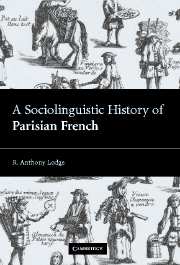Book contents
- Frontmatter
- Contents
- List of maps
- List of tables
- List of figures
- Acknowledgments
- List of phonetic symbols
- Part 1 Preliminaries
- Part 2 The pre-industrial city
- 3 The demographic take-off
- 4 The beginnings of Parisian French
- 5 The medieval written evidence
- Part 3 The proto-industrial city
- Part 4 The industrial city
- Conclusion
- Appendix Literary imitations of low-class speech
- Bibliography
- Index
3 - The demographic take-off
Published online by Cambridge University Press: 22 September 2009
- Frontmatter
- Contents
- List of maps
- List of tables
- List of figures
- Acknowledgments
- List of phonetic symbols
- Part 1 Preliminaries
- Part 2 The pre-industrial city
- 3 The demographic take-off
- 4 The beginnings of Parisian French
- 5 The medieval written evidence
- Part 3 The proto-industrial city
- Part 4 The industrial city
- Conclusion
- Appendix Literary imitations of low-class speech
- Bibliography
- Index
Summary
In this chapter let us look at the development of Paris as an urban community in the medieval or, to use Hohenberg and Lees's term, the ‘pre-industrial’ period, before considering the city's sociolinguistic development in Chapter 4. We must examine particularly the city's changing demography at this time and its relations with the hinterland populations. The chronology of events needs to be considered carefully, for significant dialect development in the city can only have occurred in conjunction with rapid population change.
The early history
The site of Paris has seen continuous human occupation for a very long time: traces of settlement have been found on the Ile-de-la-Cité, dating back some 4,000 years (Duval 1961: 43). The city appears to owe its earliest existence to the presence of an important overland route which in Neolithic times passed across the plains and plateaux of northern France from the Low Countries to the Loire and Aquitaine, and which found in the Ile-de-la-Cité the most suitable crossing-point on the Seine (see Planhol 1994: 247–8). The city's subsequent development was determined by the exceptional fertility of the plain situated north of the Seine, and by the fact that the city found itself in an area where several rivers converge (notably the Marne and the Oise with the Seine). It is no doubt for this hydrological reason that Paris's hinterland came to be referred to as the ‘Ile-de-France’ (see Bloch 1913: 9–10).
- Type
- Chapter
- Information
- A Sociolinguistic History of Parisian French , pp. 37 - 52Publisher: Cambridge University PressPrint publication year: 2004

